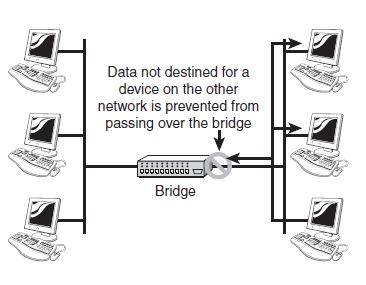Bridges
Bridges
Bridges are networking devices that connect networks. Sometimes it is necessary to divide networks into subnets to reduce the amount of traffic on each larger subnet or for security reasons. Once divided, the bridge connects the two subnets and manages the traffic flow between them. Today, network switches have largely replaced bridges.
A bridge functions by blocking or forwarding data, based on the destination MAC address written into each frame of data. If the bridge believes the destination address is on a network other than that from which the data was received, it can forward the data to the other networks to which it is connected. If the address is not on the other side of the bridge, the data is blocked from passing. Bridges “learn” the MAC addresses of devices on connected networks by “listening” to network traffic and recording the network from which the traffic originates.
The advantages of bridges are simple and significant. By preventing unnecessary traffic from
crossing onto other network segments, a bridge can dramatically reduce the amount of network traffic on a segment. Bridges also make it possible to isolate a busy network from a
not-so-busy one, thereby preventing pollution from busy nodes.

Working of bridge in segregate networks
Working of bridge in segregate networks
There are two issues that you must consider when using bridges. The first is the bridge placement, and the other is the elimination of bridging loops:
» Placement — Bridges should be positioned in the network using the 80/20 rule. This rule dictates that 80% of the data should be local and that the other 20% should be destined for devices on the other side of the bridge.
» Bridging loops — Bridging loops can occur when more than one bridge is implemented on the network. In this scenario, the bridges can confuse each other by leading one another to believe that a device is located on a certain segment when it is not. To combat the bridging loop problem, the IEEE 802.1d Spanning Tree protocol enables bridge interfaces to be assigned a value that is then used to control the bridge-learning process.
Types of Bridges
Three types of bridges are used in networks
. Transparent bridge — A transparent bridge is invisible to the other devices on the network. Transparent bridges perform only the function of blocking or forwarding data based on the MAC address; the devices on the network are oblivious to these bridges’ existence. Transparent bridges are by far the most popular types of bridges.
Translational bridge — A translational bridge can convert from one networking system to another. As you might have guessed, it translates the data it receives. Translational bridges are useful for connecting two different networks, such as Ethernet and Token Ring networks. Depending on the direction of travel, a translational bridge can add or remove information and fields from the frame as needed.
Source - route bridge —Source-route bridges were designed by IBM for use on Token Ring networks. The source-route bridge derives its name from the fact that the entire route of the frame is embedded within the frame. This allows the bridge to make specific decisions about how the frame should be forwarded through the network. The diminishing popularity of Token Ring makes the chances that you’ll work with a source-route bridge very slim.
